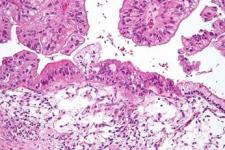Should We Sequence the DNA of Every Cancer Patient?
By Antonio Regalado,
MIT Technology Review
| 06. 14. 2016
A startup called Strata Oncology says it plans to give away advanced genetic tests to 100,000 patients struggling with cancer. But there's a profit motive: it hopes to identify patients with specific rare DNA errors and steer them to drug companies.
Strata, which was founded last year and has raised $12 million from investors, says it is set up to run 50,000 next-generation sequencing tests a year. Such tests probe the DNA of tumor tissue, searching for mutations in hundreds of genes at once, hoping to surface clues about what drug a patient should be taking.
Similar tests are already offered commercially to doctors by several companies, including Foundation Medicine of Cambridge, Massachusetts, and can cost $5,000 each.
Continue reading on MIT Technology Review
Image via Wikipedia
Related Articles
By Emily Glazer, Katherine Long, Amy Dockser Marcus, The Wall Street Journal | 11.08.2025
For months, a small company in San Francisco has been pursuing a secretive project: the birth of a genetically engineered baby.
Backed by OpenAI chief executive Sam Altman and his husband, along with Coinbase co-founder and CEO Brian Armstrong, the startup—called...
By Jessica Hamzelou, MIT Technology Review | 11.07.2025
This week, we heard that Tom Brady had his dog cloned. The former quarterback revealed that his Junie is actually a clone of Lua, a pit bull mix that died in 2023.
Brady’s announcement follows those of celebrities like Paris...
By Emily Mullin, Wired | 10.30.2025
In 2018, Chinese scientist He Jiankui shocked the world when he revealed that he had created the first gene-edited babies. Using Crispr, he tweaked the genes of three human embryos in an attempt to make them immune to HIV and...
Public domain portrait of James D. Watson by Cold Spring Harbor Laboratory
and the National Human Genome Research Institute on Wikimedia Commons
James Watson, a scientist famous for ground-breaking work on DNA and notorious for expressing his antediluvian opinions, died on November 6, at the age of 97. Watson’s scientific eminence was primarily based on the 1953 discovery of the helical structure of DNA, for which he, Francis Crick and Maurice Wilkins shared the 1962 Nobel Prize in Physiology or...




